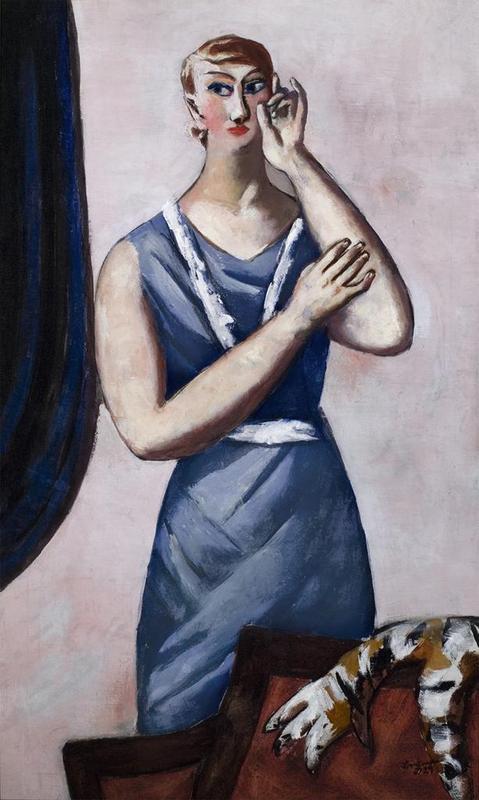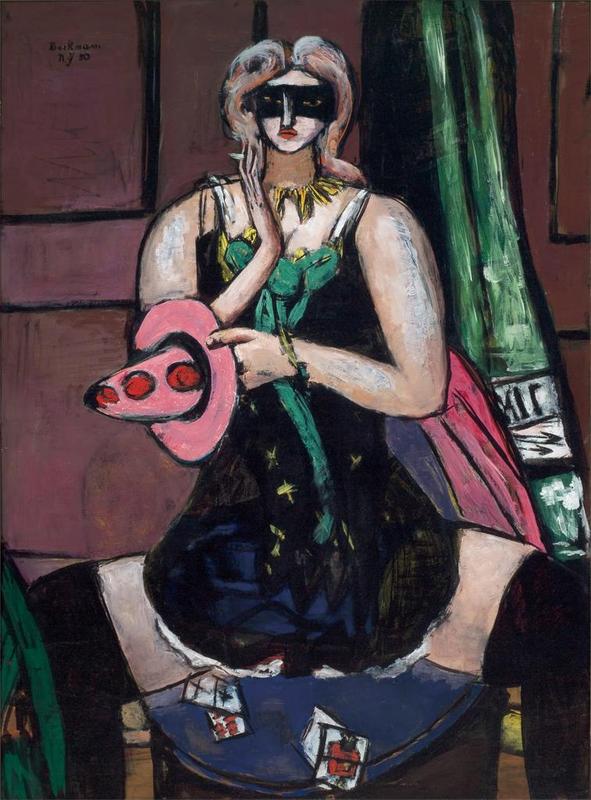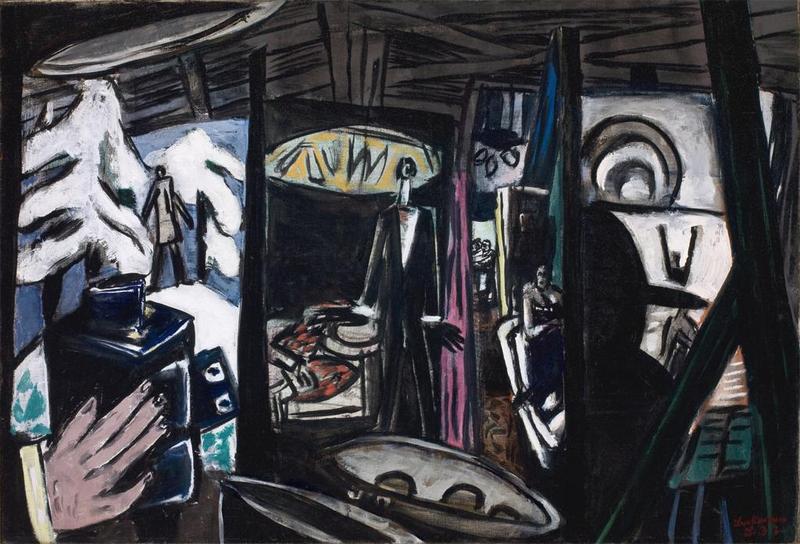Portrait of Valentine Tessier: Between Abstraction and Representation

(Cat. 2) Max Beckmann, Portrait of Valentine Tessier, 1929-1930, oil on canvas, 57 3/4 x 35 1/2 in., Saint Louis Art Museum.
"I disliked the Matisse paintings intensely. One piece of brazen impudence after another. Why don't these people just design cigarette posters." - Max Beckmann
Unlike many of his contemporaries, Beckmann took a strong yet complicated stance on abstraction. To Beckmann, artists like Matisse and their style of “new” painting, seemed “feeble and overly aesthetic;” their works failed to embody eternal human values and any sense of contemporary life.[i] In “Beckmann, Matisse, and Leger,” and “The Beckmann Effect” Carla Schulz-Hoffman and Robert Storr highlight the role Beckmann played as a vehement opponent to various modes of modernist abstraction.[ii] However, both authors also pick up on some inconsistencies in Beckmann’s contempt for abstraction. With the seemingly contradictory nature of Beckmann’s statements in mind, it seems his desire was not to wholly renounce abstraction but to view it as one pole within a balancing act between abstraction and representation: two modes he saw as equally useless in isolation. When analyzed alongside his works Carnival Mask (Figure 1), and Film Studio (Figure 2), Beckmann’s Portrait of Valentine Tessier (Cat. 2), demonstrates the ways he uses both abstract and representational forms to create highly unstable contexts in which his subjects oscillate between two ends of a pictorial spectrum.
In their essays, Schulz Hofmann and Storr struggle to categorize Beckmann, exposing his inconsistent comments on the validity of abstraction. When read together, these two accounts make clear that although Beckmann had an immense appreciation for the role formal and structural abstract elements played within a painting, he was wholly critical of what we saw as the decorative world of Matisse, Picasso, and Kandinsky’s “necktie” art.[iii] In addition, Storr and Schulz Hoffman attempt to uncover if Beckmann’s disdain for the mode of abstraction promoted by his peers brands him as one his era’s “greatest mavericks,” of simply another “ordinary philistine[e] of the period.”[iv] Within her text, Schulz-Hoffman asks the question directly: in Beckmann’s disavowal of abstraction was he simply “propagating…conservatism?”[v]
With the complex and at times contradictory nature of his statements in mind, it seems Beckmann’s desire was not to wholly renounce abstraction out of conservative taste, but rather to view it as an essential part of a balancing act between abstraction and representation integral to the creation of great art. Despite all Beckmann’s negative comments on pure abstraction, he also spoke poorly of pure representation as well.
I certainly hope we are finished with much of the past. Finished with the mindless imitation of visible reality, finished with feeble archaistic and empty decoration[vi]

(Figure 1) Max Beckmann, Carnival Mask, Green, Violet, and Pink, 1950, oil on canvas 53 3/8 x 39 9/16 in, Saint Louis Art Museum.
In Beckmann’s 1931 work Portrait of Valentine Tessier (Cat. 2), Beckmann straddles the line between representation and abstraction. The artist’s portrayal of the “premiere actress of French theater,” uses Tessier’s iconic status as a method of chaining his abstracted image of a woman to a vivid, specific, and widely recognizable real life celebrity. [vii] Furthermore the title’s insistence that this figure represents Valentine Tessier allows the viewer to gauge exactly how far this image has been abstracted through an analysis of its deviations from the conception of the actress present within their minds.[viii] This choice of subject matter emphasizes the importance Beckmann placed on the transformation of the real world into the “world of the canvas.”[ix]
At the same time, Beckmann includes a composition broken into three relatively simple and abstract blocks. Counting on the primed mind of the viewer to have seen many scenes like this before, both in life and art, Beckmann expects them to fill in the gaps where representation ends and abstraction begins. This is the force that instantaneously transforms Beckman’s shapes into a wall, a curtain, a chair, and the claw of an animal into a fur coat. Moreover, the visual slippage of objects in and out of abstraction acts as an integral factor in creating the “inherent instability” within Beckmann’s work.[x] Highlighting the prominent role this balancing act played not only in his own work, but in that of any modern artist he deemed worthwhile, Beckmann commented that “great art lies in concealing… compositional ideas in such a way that the composition looks completely natural.”[xi] Through this device Beckmann leaves his works vulnerable to a particular kind of observer effect, one in which any object viewed in isolation adds up to little more than an abstract entity.
Similarly, in Carnival Mask (Figure 1), Beckmann relegates his most abstract gestures to places that make sense within the viewer’s perception of the pictorial reality, allowing even highly abstracted marks to register as representational. His purple background streaked with black marks appears to a viewer familiar with western domestic conventions as a wall covered by a characteristic decorative molding. His simplifications of the table, curtain, and woman’s stockings, and playing cards follow suit. Beckmann thereby highlights the already abstracted nature of the representational world we occupy. Beckmann himself stated, “I hardly need to abstract things for each object is unreal enough already,” blurring the lines between conventional notions of abstraction and representation and pointing to the artifice of our own modern reality. [xii]

(Figure 2) Max Beckmann, Film Studio, 1933, oil on canvas, 25 5/8 x 37 5/8 in., Saint Louis Art Museum.
In Film Studio (Figure 2), Beckmann employs abstraction for another purpose. His depiction of a film set, full of lights, props, backdrops, and curtains gives way to seven figures all treated with varying levels of abstraction. Here, Beckmann uses the instability of the tentative border between abstraction and representation he has set up as a method of obfuscating which figures represent real humans and which are merely images of people. This technique achieved through his complex juxtaposition of differing modes of abstraction and representation served Beckmann well in the creation of his signature spaces designed to toy with the viewer’s sense of reality.
Overall, Beckmann’s ability to create the complicated effects seen in Portrait of Valentine Tessier, Carnival Mask, and Film Studio through his personalized use of abstraction, allow Beckmann to escape categorization as conservative curmudgeon afraid of abstraction and the death of traditional painting. Instead, with his complex, effective and personalized use of abstraction in mind, we can see Beckmann as an artist unimpressed by the use of French abstraction to achieve nothing more than a work with a singular decorative and visual read. In his essay, Storr writes about a “push-pull” that exists in Beckmann’s work as a “contest between volume and compression.”[xiii] However, Beckmann’s purposeful employment of simultaneously abstract and representational elements seems to constitute another type of push-pull. Furthermore, his employment of this tension between abstraction and representation, somewhat resolves the confusing nature of Beckmann’s conflicted statement and eradicates the need to place him on either side of a modern dichotomy. When viewing Beckmann’s critical comments on abstraction with other statements that belie his interest in the field and a disinterest in traditional painting, we can see the crucial role both abstraction and representation played in Beckmann’s work.
[i] Beckmann, Self-Portrait in Words, 115-116.
[ii] Carla Schulz-Hoffman, “Beckmann, Matisse, Leger,” Max Beckmann and Paris: Matisse Picasso Braque Leǵer Rouault, (St. Louis, [MO] : Zurich : Köln: The Saint Louis Art Museum ; Kunsthaus Zürich ; Taschen, 1998).; Robert Storr, “The Beckmann Effect,” Max Beckmann (New York: Museum of Modern Art : [Distributed in the United States and Canada by D.A.P./Distributed Art Publishers], 2003).
[iii] Beckmann’s description of the “new arts” and its characteristic “arts and crafts flatness” can be found in his “Timely and Untimely Art,” within Max Beckmann, Self-Portrait in Word, 114-115; Schulz-Hoffman discusses Beckmann’s mixed comments abstraction here: Schulz-Hoffman, “Beckmann, Matisse, Leger,” 84-86; Storr picks up on this discussion and highlights Beckmann’s comment on “necktie art” here: Storr, “The Beckmann Effect,” 14-16.
[iv] Storr, “The Beckmann Effect,” 16.
[v] Schulz-Hoffman, “Beckmann, Matisse, Leger,” 84.
[vi] Schulz-Hoffman, “Beckmann, Matisse, Leger,” 84.
[vii] Bezzola and Homburg, Max Beckmann and Paris, 227.
[viii] One critic of the Parisian exhibition in which this work was shown noted Beckmann’s departure form the “grace of the sinuous actress” as he transformed her into a “milkmaid” with “bovine eyes and heavy arms.” Tobia Bezzola, “German Follies,”Max Beckmann, Self-Portrait in Words: Collected Writings and Statements, 1903-1950 (Chicago, Ill: University of Chicago Press, 1997), 148.
[ix] “The uniform…is seeking,” From “On My Painting” a speech given by Max Beckmann recorded in Beckmann, Self-Portrait in Words. 305.
[x] Storr notes instability in Beckmann’s work, “Beckmann of…his compositions,” “In every…their minds,” Storr, “The Beckmann Effect,”12, 38.
[xi] Storr, “The Beckmann Effect,” 16.
[xii] Charles S. Kessler, Max Beckmann’s Triptychs (Cambridge: Belknap Press of Harvard University Press, 1970), 105.
[xiii] Storr, “The Beckmann Effect,” 34.